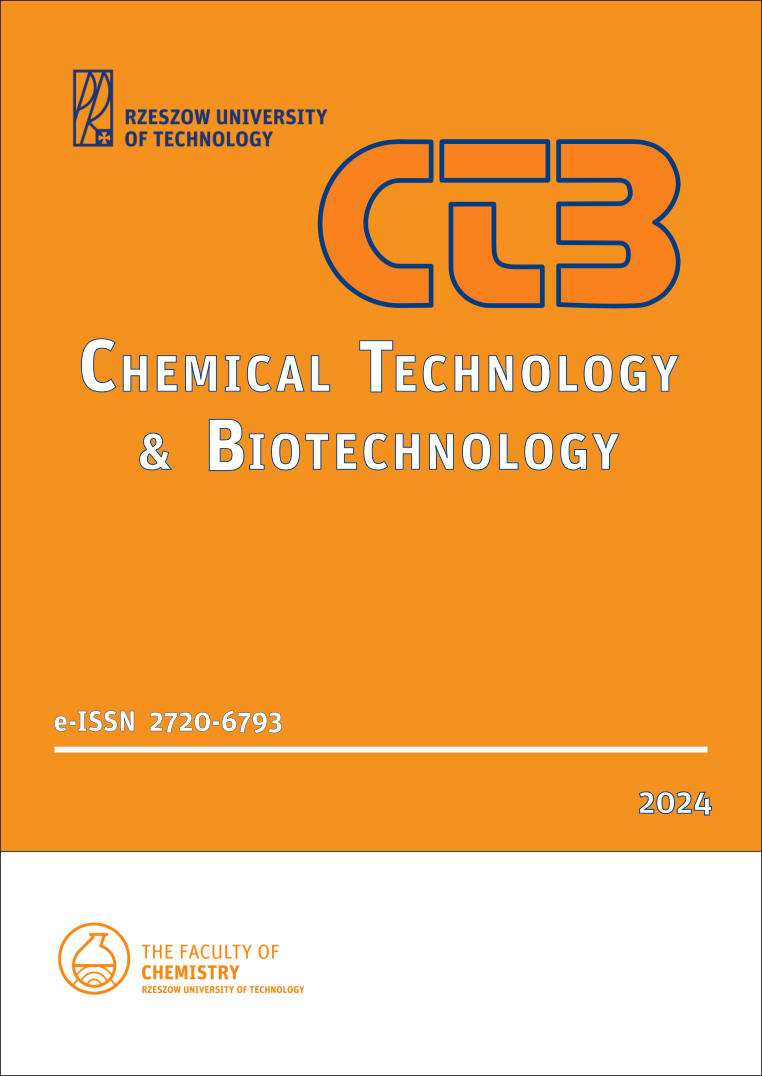Abstract
This paper presents the results of studies on the products of hydroxyacetone and hydroxyacetone tosylate dithioketalization with ethane-1,2-dithiol and propane-1,3-dithiol. The process was carried out in an inert gas atmosphere, argon, or in the air atmosphere and with a variable excess of one of the substrates, here the dithiol reagent. The structure elucidation and the reaction mechanism for the formation of the isolated products have been discussed. Structure products were confirmed using 1H NMR and 13C NMR spectroscopy as well as mass spectrometry. The structure of one of the main products, 1,2-bis((2-methyl-1,4-dithian-2-yl)thio)ethane, was confirmed by single-crystal X-ray diffraction analysis. It was obtained with yield up to 62%. The studied dithioketalization process of selected ketones allows for the efficient synthesis of 2-methyl-1,3-dithiolan-2-yl)methanol, (2-methyl-1,3-dithian-2-yl)methanol and 3-((2-methyl-1,4-dithiepan-2-yl)thio)propane-1-thiol with yields of 63%, 66% and 50% respectively. Furthermore, we disclose an alternative synthesis of 5-methyl-2,3-dihydro-1,4-dithiine, a synthetically useful building block.
References
(a) Greene, T.W.; Wuts, P.G.M. Protective Groups in Organic Chemistry, 3rd Ed., J. Wiley & Sons Inc. 1999, 329-344. (b) Kocieński, P.J. Protecting Groups, 3rd Ed., Thieme, 2005, 77-78.
Ling, X.; Zhang, S.; Shao, P.; Wang, P.; Ma, X.; Bai, M. „Synthesis of a reactive oxygen species responsive heterobifunctional thioketal linker", Tetrahedron Lett., 56(37), 5242–5244. doi:10.1016/j.tetlet.2015.07.059
Rinaldi, A; Caraffi, R.; Grazioli, M.V.; Oddone, N.; Giardino, L.; Tosi, G. and four more „Applications of the ROS-Responsive Thioketal Linker for the Production of Smart Nanomedicines”, Polymers, 2022, 14, 687-704. https://doi.org/10.3390/polym14040687
Buszta, N.; Depa, W.J.; Bajek, A.; Groszek, G. “Convenient method to obtain homoallylic thioethers from aromatic dithioacetal derivatives”, Chemical Papers, 2019, 73 (11), 2885-2888. https://doi.org/10.1007/s11696-019-00837-3
(a) Depa, W. J.; Buszta, N.; Guńka, P.A.; Zachara, J.; Bajek-Bil, A.; Groszek, G., „Chirality transfer in the synthesis of 2,3-dihydro-1,4-dithiine derivatives”, Synth.Commun., 2020, 50(22), 3397-3403. https://doi.org/10.1080/00397911.2020.1801746. (b) Leja, D.T.; Depa, W.J.; Guńka, P.A.; Zachara, J., Lechowicz, J.B., Groszek, G., „New heterocyclic organosulfur compounds derived from dithioacetals”, Synlett, 2024, https://doi.org/10.1055/a-2259-3689
Afonso, C. A. M.; Barros, M. T.; Godinho, L. S.; Maycock, C. D., „Synthesis of 2,3-Dihydro-1,4-dithiins and 2-Aldylidene-1,4-dithianes by 1,2-Sulfur Migration in 2-(1-Hydroxyalkyl)-1,3-dithiolanes”, Synthesis. 1991, 1991, 575–580. DOI: 10.1055/s-1991-26520.
Jang, J. Y.; Do J. Y., “Refractive index changes in polyacrylates bearing alkyl sulfur groups through the sulfur oxidation reaction”, React. Funct. Polym., 2015, 91-92, 28-34. https://doi.org/10.1016/j.reactfunc polym.2015.04.005
https://www.coursehero.com/sg/organic-chemistry/sulfur-nucleophiles/, 18.06.2024
Crystal data for compound 2: C12H22S6 (M =358.705 g/mol): triclinic, space group P1 ̅ (no. 2), a = 5.9899(1) Å, b = 7.7228(2) Å, c = 9.8079(3) Å, α = 93.666(2)°, β = 92.363(2)°, γ = 109.581(2)°, V = 425.640(19) Å3, Z = 1, T = 297 K, μ(Mo Kα) = 0.786 mm-1, ρ = 1.40 g/cm3, 29994 reflections measured (6.72° ≤ 2Θ ≤ 65.44°), 3011 unique (Rint = 0.033, Rsigma = 0.019) which were used in all calculations. The final R1 was 0.026 (I ≥ 2σ(I)), and wR2 was 0.046 (all data). CCDC 2364133 contains the supplementary crystallographic data for this paper. The data can be obtained free of charge from The Cambridge Crystallographic Data Centre.
(a) Wood, W. W. „Trends in the Chemistry of 1,3-Dithioacetals. In Organosulfur Chemistry, Synthetic Aspects”, Chapter 4; Page, P., Ed.; Academic Press: London, 1995, 133–224. (b) Sromek, A. W.; Gevorgyan, V., „1.2-Sulfur Migrations”. Vol. 274. In Sulfur-Mediated Rearrangements, Topics in Current Chemistry, 1st Ed.; Springer: Berlin, Heidelberg, 2007, 110–114.
Van, L.C.; Le Tran, B. T.; Thi, N.; Trong, D. H.; Van, T. D.; Mai, T. D. and 3 more, „Comparison of supercontinuum generation spectral intensity in benzene‑core PCFs with different types of lattices in the claddings.” Opt. Quantum Electronics, 2022, 54, art. 840. https://doi.org/10.1007/s11082-022-04218-11 3
Ryckaert, B.; Demeyere, E.; Degroote, F.; Janssens, H.; Winne, J.M., “1,4-Dithianes: attractive C2-building blocks for the synthesis of complex molecular architectures”, Beilstein J. Org. Chem., 2023, 19, 115-132. https://doi.org/10.3762/bjoc.19.12
Bottini, A.; Böttner, E.F. “2-Methyl-5,6-dihydro-l,4-dithiin and 2-Methyl-6,7-dihydro-5H-dithiepin from 2-Chloroallylthioalkanethiols”, J. Org. Chem. 1966, 31, 586-587. DOI: 10.1021/jo01340a502


